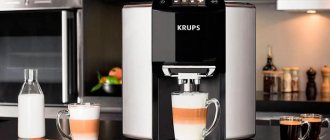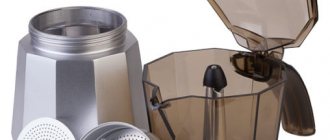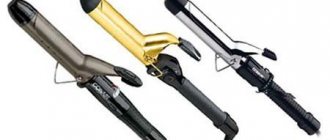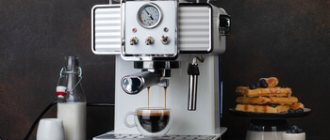Most coffee lovers around the world claim that espresso machines offer more authentic, rich and creamy coffee. An espresso machine also allows you to choose different types of coffee depending on your mood, taste or desired strength.
In comparison, coffee makers are a single function machine and will certainly produce one type of weaker coffee. If you are a coffee lover, you will almost certainly prefer the end product delivered by an espresso machine.
carob coffee maker
In the Russian-speaking environment, the classification is not the same. If in the English-speaking environment machines are divided into coffee makers (coffee makers) and espresso machines (espresso machines), then in the Russian-speaking environment: into coffee makers and espresso coffee makers (coffee machines).
It is believed that a coffee machine has one main feature - grinding and brewing coffee in one cycle. Meanwhile, so-called carob coffee makers, at least a few of them, have a built-in coffee grinder and they brew espresso.
In this article we will talk about carob-type coffee makers. They can be divided into two categories: amateur (home) and professional coffee makers for use in coffee establishments and catering establishments.
Carob coffee makers have almost the same structure. They can vary in functionality, power, quality and price.
The operating principle of the most popular and largest class of coffee making devices is simple: ground coffee is placed in a reservoir called a horn and compacted with a tamper in the form of a coffee tablet. Water converted into steam passes through it under high pressure and flows down in the form of a strong, high-quality finished drink.
Carob coffee makers are available for both coffee beginners and professionals who want to make espresso.
Pump carob coffee maker
A pump creates pressure in them . Preparing espresso requires a pressure of 9 bar. Many manufacturers indicate a pressure of up to 15 bar and this should be understood as the pressure at the water outlet from the pump. And when water enters the horn, the pressure drops to 7-9 bar.
Pumps are vibrating and rotary . If a special piston (piston) oscillates and creates pressure, such a pump is called vibrating . That is, the pump piston moves water in different directions. The pressure generated by the oscillatory movement is discrete, that is, uneven. Therefore, this type of pump is cheap and compact.
Industrial (professional) coffee makers are equipped with rotary pumps . In them, a motor rotates the scooping and pushing water along the hydrological path, the impeller at a constant speed. Such pumps create stable and uniform pressure. They are expensive and big. Professional carob coffee makers in coffee shops and restaurants with rotary pumps are therefore significantly large devices.
For entry-level and mid-level coffee makers, a vibration pump is largely sufficient and it has a disproportionately small effect on the finished drink and its quality. This type of pump is found in cheap and expensive coffee makers.
In a coffee maker, water is heated to the desired brewing temperature (95-98 degrees) using a boiler , thermoblock thermostat heating system .
There are products that can operate at higher temperatures than 98 degrees. This heating system is needed for frothed milk after brewing coffee. These coffee makers have an additional heating system for hot water and steam.
Steam coffee maker
Pumpless (steam, boiler) carob coffee makers heat and supply water to the carob naturally. Their pressure does not exceed 4 bar, which is not enough to make espresso.
With low pressure, while the coffee maker is loading, the steam will have time to overheat and the coffee powder will lose its pleasant aroma.
There are no devices that increase pressure in steam coffee makers. On the contrary, a metal boiler with a water heating element is installed. The resulting steam forces water into the cone containing the coffee tablet.
Thus, steam horn coffee makers brew something similar to filter coffee, not espresso.
In an internal boiler, in a sealed tank, water is brought to a boil in a matter of minutes. Such overheated water, passing through ground coffee, produces a drink that is bitter or sour. Coffee is prepared within 2 minutes. Due to the fact that the steam will quickly absorb the beneficial properties of ground coffee, the caffeine content of the drink will be higher than from a pump device. However, the aroma of the drink will not be too strong.
Types of coffee machines
There are two most popular models of carob coffee makers - pump and steam, each model has its own pros and cons, as well as the distinctive properties of the coffee that can be obtained from them.
Steam - pros and cons, examples
What does a carob steam coffee machine mean:
- This is a device in which water is forced through a coffee pill using steam. It is formed when liquid boils in a boiler.
- The pressure does not rise above 4 - 5 bar, so the extraction efficiency is not high.
- As the water is brought to a boil, the coffee tastes harsh.
- There is no thermostat in steam models, since it is not needed due to design features.
Steam coffee makers are inexpensive, their cost can vary from 2 thousand rubles. They are small in size, so they fit wherever there is little space. The speed of preparing the drink is higher than in a drip coffee maker or French press.
The quality of work does not meet the criteria for delicious coffee, so they are purchased out of ignorance due to the low price. There are few recipes with the basic configuration - cappuccino and espresso. A manual cappuccino maker - pannarello - usually causes difficulties in use.
Which steam coffee maker can you buy:
- Scarlett;
- Polaris;
- Rowenta Allegro;
- Redmond;
- Shinbo.
In first place in terms of the quality of drinks, cost and reliability is the Polaris RSM 4002 model. According to customer reviews, this device organically combines price and quality. All others have worse coffee characteristics after brewing.
Pump-action - advantages and disadvantages, models to choose from
Pump coffee makers have the same operating principle as all carob coffee makers. The water is heated not to the point of boiling - this is a positive quality, but only up to 93 degrees. Next, the pump is turned on with a total pressure of 15 bar (9 of which are working), pushing the liquid through the coffee tablet.
Advantages of a pump coffee maker:
- The aroma of coffee is better preserved;
- cooking speed up to 1 minute;
- In addition to the basic configuration, the design includes many additional functions.
Flaws:
- pump machines are much more expensive than steam engines;
- The dimensions of the device are larger due to large water tanks.
It is better to buy and use pump coffee makers for those people who often brew espresso in large quantities, preferring the good taste, like in coffee shops. Machines require regular care and maintenance to maintain their stated performance.
The cappuccino maker in a pump machine can be automatic - remote or built-in. According to customer reviews, they do not really like milk containers that cannot be removed and washed, and the milk tubes cannot be cleaned.
Models to consider:
- Saeko;
- Bork;
- DeLonghi;
- Nespresso;
- Yura;
- Kenwood.
In first place in popularity is the Delonghi Esam - a miniature coffee machine, although it is difficult for non-professionals to accurately determine the difference between a coffee maker and a coffee machine. The guideline is a price of up to 20 thousand rubles.
Among pump-action carob coffee makers, there are models for home and professional use. This is an important indicator, since household appliances are designed for high loads and warranty repairs will not be carried out if the device breaks down quickly.
Interesting! There is another subclass of pump carob coffee makers that require high skill in preparing drinks - lever ones. These are rare models in which very fine settings are possible. Manual coffee maker. Water supply is carried out using a lever. Such devices are not very common and are designed for preparing coffee from unique varieties, which require their own method of extraction under pressure
Carob lever coffee makers
This is a purely professional subclass of carob coffee makers, where the pressure is achieved and adjusted manually using a special mechanical lever. The quality of coffee depends on the skills of the barista and he works with a pump.
Coffee maker water reservoir. For ease of maintenance, coffee makers are made with a removable reservoir.
Carob coffee makers have additional features such as a removable tray, the ability to use coffee in pods, a double nozzle, an automatic coffee dispenser, and an auto shut-off.
How is water heated?
The quality of espresso depends on such basic parameters as water pressure and temperature. Therefore, a carob coffee maker has another important element - a water heating device. Stable and ideal temperature gives the best drink.
To heat water, use a thermoblock, boilers of different sizes, or a boiler containing a heat exchanger. In 80% of cases, Italian ULKA/CEME is used. A flow-through thermoblock or a small boiler (more than 100 ml) is installed in entry-level coffee makers. Expensive options are equipped with a large boiler (from 200 to 400 ml) or a boiler with a heat exchanger.
A preheated thermoblock immediately supplies hot water in any volume. However, they can create temperature differences.
A small boiler supplies a small volume of water at the required temperature, but requires reheating.
A large volume boiler supplies a large volume of water at the required temperature without additional heating. But it takes longer to initially heat up.
There is a coil in the heat exchanger chamber. Water passing through a system of tubes is heated to a stable temperature. However, initial heating takes a long time. The water, initially heated and superheated in the heat exchanger to too high a temperature, is then drained by performing a “idle flow” into the pan.
Coffee makers are also produced with two boilers, the steam from one of them is used to froth milk, and the second is used to make espresso.
Brewing group and coffee maker horn
The brewing group contains a horn , filter and additional elements to improve the quality of coffee. The actual coffee extraction process takes place in the group.
The coffee maker's horn is a handle with a filter holder for a coffee tablet. It is made of metal or plastic. Metal horns are preferred. Cheaper horns use plastic.
The diameter of the horns is 50, 54, 57, 58 mm. Professional classic diameter - 58 mm. For coffee makers with a horn diameter of 58 mm, the easiest way is to purchase higher-class portafilters and filters for every taste. Cheaper coffee makers are often equipped with horns of 50 or 54 mm diameter.
A portafilter or basket, simply a filter, is a key element in the brew group.
A simple filter means that the coffee flows without any additional equipment or steps. The filter is a regular fine mesh. Such a filter will require barista qualifications.
A coffee maker intended for the masses has filters with “improvers” . Such coffee makers are divided according to the presence and type of “improver”. This is a structural element responsible for bringing the pressure in the brewing group to parameters close to the reference ones. It may either be absent or be in the form of a double bottom or valve system. A sign of a professional class is the absence of an “improver”.
Then there are more opportunities for manual participation in the process to obtain potentially maximum results. However, this requires skill in selecting the grind and tamping the coffee tablet.
Filters with “improvers” are either a filter that has a double bottom (one bottom has many holes, the second has one hole), or multi-layer mesh filters , or these are spring filters that serve coffee at a certain pressure in the horn.
The valve system is more efficient, but requires more complex maintenance. The double bottom basket is easier to clean and contains no plastic. But with a valve system the result is better. These are different systems that correct errors and improve the taste of espresso.
By automating the process, they prevent user errors. However, while reducing intervention, the improver does not produce the excellent espresso obtained with manual operation.
The improver and filter are included with the coffee maker, you buy them together and you will not be able to exchange them for another one.
It is recommended to choose portafilters without plastic and without rubber seals. Also, a filter with a double bottom creates difficulties when cleaning finely ground coffee. Filters need to be cleaned regularly.
Electronic components of coffee makers with a coffee horn
Espresso coffee makers have only two electronic components: an automatic dosing system and a PID controller .
Using the automatic dispenser, you can adjust the amount of water that the coffee maker dispenses in one start. As a rule, a coffee maker can brew single and double volume espresso. You can change the volume of water up or down to adjust the mode to a certain degree of coffee grinding.
An electronic boiler temperature control device (otherwise known as PID) stabilizes the temperature of the spilled water. This device is found in professional coffee makers and middle-class devices. You will have to pay extra for the PID system.
Carob coffee makers also have a three-way valve , they are also called a solenoid. This element helps relieve pressure in the brew group immediately after the water supply has stopped. That is, the drops from the horn stop, the coffee tablet becomes drier. This in turn makes the filter cleaning process easier. Coffee makers equipped with a solenoid are considered middle class and more expensive.
There are also carob coffee makers on the market that dispense heated milk. A special container is provided for milk; such a machine will automatically prepare coffee with milk, such as latte and cappuccino. Automatic cappuccino makers simplify the process of preparing drinks with milk.
What drinks can you prepare?
The main drinks prepared in a coffee machine are espresso and cappuccino. Also available:
- Latte, which differs in different proportions of milk and the way it is poured into the glass.
- Americano with double water. Can be prepared with warm or cold milk. Essentially - diluted espresso.
- Glace – espresso or Americano with the addition of ice cream.
- Irish coffee - double strong espresso with cream and alcohol - Irish whiskey.
Medium-ground green coffee, loose or in pods, is also suitable for extraction. Its strength decreases slightly when prepared using the espresso method, but the caffeine is noticeable.
Advantages and disadvantages of carob coffee makers
pros
- Ease of control
- Great functionality and ergonomics
- Reliable and durable housing
- Possibility of preparing delicious coffee with thick foam
- Equipped with a cappuccino maker of many models
- Clean in use
- The ability to preserve the natural taste of the variety
- Economy
- Possibility to create a stable foam
- Can brew a drink instantly
- Cook several servings at once
- There is no need to monitor the cooking process
Minuses
- quite high cost
- limited choice of coffee
- mandatory descaling
- active human participation in the cooking process
- skill requirement for compacting ground coffee in a cone
- the need for a tamper to compact the powder
- lack of built-in coffee grinder
- large dimensions
Carob coffee makers care
Most carob coffee makers do not have an automatic cleaning system, so you must take care of the device yourself. You must remember to wash the coffee maker after each use every day.
Quite often it is necessary to clean the coffee horn from coffee oils. For these purposes, special tablets for coffee fats are produced. To do this, place the tablet in the horn and turn on the water flow on the coffee maker. As soon as water starts dripping, you need to turn off the coffee maker. After a pause of 10-15 minutes, the procedure must be repeated several more times. Thus, you need to pass 2-3 liters of water to remove any remaining product and deposits.
The class of coffee makers for home has hundreds of different models. The choice should not be based on specific brands and models, but on design platforms.
How to brew coffee in an espresso maker
A carob coffee maker is not a fully automatic coffee machine and involves manual operation. You do the grinding of beans (buying ground coffee), putting coffee in the filter, installing the horn, starting (stopping), and cleaning yourself.
After switching on, the carob coffee maker requires warming up; it is necessary to pour hot water over the group and the carob, and warm up the boiler so that the water is at a uniform temperature.
You will also need a separate burr grinder, these are discussed in another article.
It is also necessary to develop and refine your skills in compacting coffee tablets using your home coffee maker. To do this, you need to purchase a filter with a single bottom for the device, that is, without any kind of improver. Such filters are included with even the simplest coffee makers with a horn with a diameter of 50 mm.
When using filters without an improver, skill in forming a coffee tablet and selecting the correct grind are the most necessary conditions. The coffee tablet itself is responsible for pumping up the required pressure in the brewing chamber and the quality of the drink.
When using a filter with an improver, the correct formation of the coffee tablet loses its importance. But the correct grinding matters in any case.
Fresh grinding to the correct degree on a burr grinder makes a big difference.
With filters without an enhancer, the art of brewing the best espresso is put to the test.
After connecting to the network, it is advisable to warm up the coffee maker for several minutes, then empty the filter horn without coffee and warm it up again.
Pour espresso only after the ready indicator flashes.
If you own a coffee maker with a small storage boiler, limit the supply to a single dose of 60 ml. Only after a few minutes of heating, pour the next portion. For coffee makers with a thermoblock, this requirement does not matter.
The process of brewing espresso on a carob home coffee maker is greatly simplified by using pods .
Characteristics of entry-level pump carob coffee maker options for 2021:
Middle class - a boiler with a volume increased to 200-400 ml, a horn without plastic elements of increased diameter with filters without improvers, with additional modules such as a three-way valve and/or PID controller, etc. Without a burr grinder, using such a technique makes no sense.
The best carob coffee makers come with a variety of features. You can adjust the temperature, foam density, amount of milk and water.
Preparing coffee: grinding and its features
Preparing a drink in a carob coffee maker requires proper grinding of the beans . This is one of the most important parameters affecting the taste of coffee. Note! Pay attention to the grains before grinding. They must be fresh, fried and dry. Wet beans produce a low quality drink. In case of accidental contact with water, dry the grains in the oven.
Coarse grinding with too large particles gives the drink a sour taste. Grinding that is too fine, in which the grains are reduced to almost the state of flour, is only suitable for drip coffee makers and Turkish coffee makers. It is better not to use it in a carob coffee maker.
Most often, medium grinding, with a particle size of about 1 mm, is used . This size will not allow the grounds to seep through the filter and will saturate the coffee with a bright taste.
You should not grind grains in a hurry, since the device can cope with the task most effectively only with the same particle size. In order to achieve a uniform consistency, use an automatic coffee grinder with a choice of grain sizes.
How to choose a carob coffee maker
The taste and speed of cooking depend, firstly, on the material. In a steel horn, the drink will heat up faster and more evenly.
The packaging is also important. Carob coffee machines have water reservoirs from 0.2 to 2 liters. The larger the container, the higher the fluid pressure.
For delicate milk froth you need a coffee maker with a cappuccino maker. It can be automatic or manual. In the second case, you will need a special tube with a nozzle, which is lowered into the milk.
If fast loading is important to you, choose a device with pods . These are filter bags made of two-layer perforated paper. This packaging improves the taste.
What to look for?
In the selection process before purchasing a coffee maker, it is recommended to pay attention to the following characteristics:
power - ranges from 250 to 2500 W, the speed of coffee preparation depends on the power;
heater type - the boiler heats the entire volume of water, the thermoblock heats the water in portions;
control type - control is carried out using buttons or a lever, a touch screen or using a mobile application;
volume - coffee makers are equipped with a reservoir, the volume of which is enough to prepare at least two cups of coffee;
additional options - delayed start using a timer, a sound signal when the drink is ready, protection of the device from overloads.
Recommendations for selection and important criteria
When choosing a suitable model for your home, you need to pay attention to the following characteristics:
- Functional.
- Pods.
- Possibility of making cappuccino.
- Dimensions of compartments where water is stored.
- How many horns there will be, what materials they are made of.
There are several horns in a coffee machine, but there are models with only one. This is an economy class that is represented quite well on the market. In this case, you can prepare no more than 2-3 cups at a time; for a large family or office, such an approach can hardly be called convenient.
Stainless steel is the highest quality material for the production of horns. Kits are often supplemented with filters made of the same materials, because it is this part that produces foam. Heating of metal analogs occurs faster if you compare the performance with plastic. There is less chance of getting a finished drink with a sour taste; its aroma is real.
As for capacity, there are practically no restrictions on it. 0.5 liters is the standard volume for a carob coffee maker with pressure up to 4 bar. A 1.5 liter cup is required for models that support a level of 15 bar or more.
Important. It’s good if the model has a removable water bowl. Then it is easier to keep the device clean and provide normal care.
It's worth taking a closer look at the cappuccino maker. Even if from the very beginning it seems that this function is unlikely to be useful. Immersing this part in cold milk is a standard procedure. Foam is formed when steam is released.
The same goes for the function that allows you to use pods. This brings variety to ordinary life and allows you to develop taste preferences.
Interesting. Pods are coffee with the correct roasting and degree of grinding, in the form of individual portions. For one-time use only.
Filters are often layers of paper with powder placed between them. Pods simplify not only operation, but also maintenance of equipment. Then drinks are prepared with a minimum of labor costs. Which means you get results faster.
The following functions will probably be useful:
- Warming cups. Instantly increases the cost, but microwave ovens can easily replace this option.
- Automatic heating. Relevant if you want to prepare portions of coffee in advance.
- Stock button. Stops the cooking process if necessary.
- Removable tray in which drops are collected.
- Additional pump so you can prepare two different types of coffee at the same time.
- Overheat protection, extending service life and guaranteeing safety.
- Indicator of the presence or absence of water in the required quantity.











